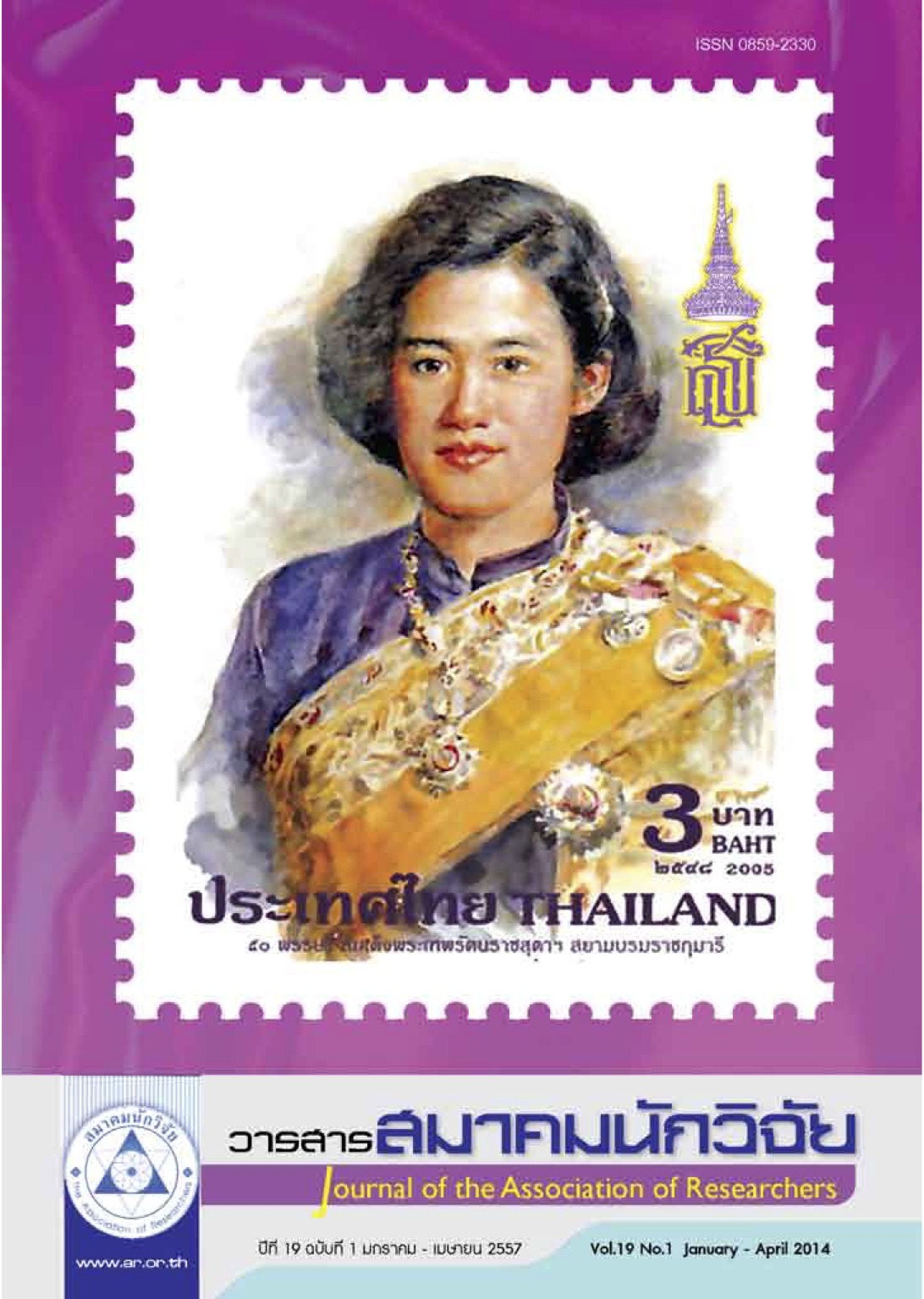ANTECEDENTS AND CONSEQUENCE OF STRATEGIC LEADERSHIP CAPABILITIES OF HIGHER EDUCATION INSTITUTE IN THAILAND
Main Article Content
Abstract
The purpose of this research is to study their self-efficacy, adaptive capacity, corporate social responsibility and competitive awareness which effect strategic leadership capabilities and to study the strategic leadership capabilities that have effect on organizational effectiveness. The data was collected from 188 presidents and deans of higher education Institutes in Thailand as the sample by questionnaires and analyzed by multiple regression analysis and simple regression analysis to test the hypothesizes. The findings indicate that the three antecedents include self-efficacy, adaptive capacity and corporate social responsibility positive effect on strategic leadership capabilities except the competitive awareness. Similarly, strategic leadership capabilities have positive impact on organizational effectiveness. This finding helps the executives of higher education institutes in Thailand for their self development and organizational effectiveness which lead to advantages in sustainable competitiveness.
Article Details
บทความที่ปรากฏในวารสารนี้ เป็นความรับผิดชอบของผู้เขียน ซึ่งสมาคมนักวิจัยไม่จำเป็นต้องเห็นด้วยเสมอไป การนำเสนอผลงานวิจัยและบทความในวารสารนี้ไปเผยแพร่สามารถกระทำได้ โดยระบุแหล่งอ้างอิงจาก "วารสารสมาคมนักวิจัย"
References
ขาบธัช ปัญจมะวัต. (2551). ผลกระทบความรับผิดชอบต่อสังคมต่อการเพิ่มมูลค่าธุรกิจ ของบริษัทจดทะเบียนในต ลาดหลักทรัพย์แห่งประเทศไทย. คณะการบัญชี มหาวิทยาลัยธุรกิจบัณฑิตย์.
ชมพู โกติรัมย์. (2554, พฤษภาคม 28). มหาวิทยาลัยกับความรับผิดชอบต่อสังคม. ไทยโพสต์. ค้นเมื่อ 4 มิถุนายน 2554, จาก http://www.thaipost.net/node/39296.
จีรพัฒน์ ศิริรักษ์, ชไมพร ใจแปง. (2552). ความรับผิดชอบต่อสังคม (CSR) พฤติกรรมที่พึงประสงค์ในองค์กร. คณะสังคมศาสตร์และสวัสดิการสังคม มหาวิทยาลัยหัวเฉียว.
ตามพงษ์ วงษ์จันทร์. (2552). เตรียมความพร้อมเข้าสู่ตลาดแรงงาน คุณจะต้องเตรียมตัวอย่างไร. โลกของอาชีพ ข้อคิดในการทำงาน. ค้นเมื่อ 23 มิถุนายน 2555, จาก http://www.stou.ac.th/Offices/Oes/OesPage/ Guide/career/career_page2/box004.html.
นฤมล สุภาทอง. (2550). ภาวะผู้นำเชิงกลยุทธ์ของผู้บริหารที่ส่งผลต่อประสิทธิผลโรงเรียน สังกัดสำนักงานเขตพื้นที่ การศึกษานครพนม เขต 2. วิทยานิพนธ์ มหาวิทยาลัยราชภัฏสกลนคร.
นวลลักขณ์ บุษบง. (2550). การวิเคราะห์ปัจจัยที่ส่งผลต่อประสิทธิผลองค์การของวิทยาลัยพยาบาล สังกัดกระทรวงกลาโหม. กทม.: สำนักงานเลขาธิการสภาการศึกษา (สกศ.)
พิศสุภา ปัจฉิมสวัสดิ์. (2552). การวิเคราะห์ปัจจัยภาวะผู้นำของหัวหน้าภาควิชาที่ส่งผลต่อประสิทธิผลองค์การของภาควิชาในสถาบันอุดมศึกษาเอกชน. จุฬาลงกรณ์มหาวิทยาลัย.
ภาวิช ทองโรจน์. (2555). สภาสถาบันอุดมศึกษากับการพัฒนาอุดมศึกษา. ค้นเมื่อ 18 พฤษภาคม 2555, จาก http://www.dusit. ac.th/course/standard/No-3.pdf. CEO Talk. (2550, เมษายน 28-30). ประชาชาติธุรกิจ. หนา้ 34.
อัมพร อิสสรารักษ์. (2548). ความสัมพันธ์ระหว่างภาวะผู้นำกับประสิทธิผลของโรงเรียนมัธยมศึกษาเขตภาคตะวันออก. วิทยานิพนธ์ (กศ.ม.) มหาวิทยาลัยบูรพา.
Anderson, D. W., Krajewski, H. T., Goffin, R. D., & Jackson, D. N. (2008). A Leadership Self-Efficacy Taxonomy and its Relation to Effective. Leadership Quarterly, 19(5), 595-608.
Auh, S. & Menguc, B. (2005). Balancing exploration and exploitation: The moderating role of competitive intensity. Journal of Business Research, 58(12), 1652-1661.
Bandura, A. (1986). The Social Foundations of Thought and Action, Englewood Cliffs, NJ: Prentice-Hall, Boal, K. B. & Schultz, P. L. (2007). Storytelling, time, and evolution: The role of strategic leadership in complex adaptive systems. The Leadership Quarterly,18(4), 411-428
McCormick, M. J., Tanguma, J., & López-Forment, A. S. (2002). Extending self-efficacy theory to leadership: A review and empirical test. Journal of Leadership Education, 1(2), 34-49
Gajewski, M. (2012). What is Adaptive Capacity? Changing River Consulting. Retrieved May 20, 2013, form http://www.changing-river.com/2012/05/what-is-adaptive-capacity/.
Hair, J. F., Black, W. C., Babin, B., Anderson, R. E., & Tatham, R. L. (2006). Multivariate data analysis 6thEd. Prentice Hall.
Hitt, M. A. (1998). Twenty-first century organizations: Business firms, business schools, and the Academy. Academy of Management Review, 23(2), 218-224.
Hitt, M. A., Haynes, K. T., & Serpa, R. (2010). Strategic leadership for the 21st century.Business Horizons, 53(5), 437-444.
Nikitakos, N., Maria, A. & Lambrou, M. A. (2007). Digital shipping: The Greek experience. Research in Transportation Economics, 21(1), 383–417.
O’Cass, A., & Weerawardena, J. (2009). The effects of perceived industry competitive intensity and marketing-related capabilities: Drivers of superior brand performance. Industrial Marketing Management, 6(9), 1-11.
Sansook, J. & Ussahawanitchakit, P. (2008). The influences of teamwork on organizational effectiveness: An empirical study of automotive manufacturing in Thailand. International Journal of Strategic Management, 8(2)
Thomas, R. J. (2008). Crucibles of leadership: How to learn from experience to become a great leader. Harvard Business School Press.
Ussahawanitchakit, P. (2011). Strategic leadership, organizational learning, organizational innovation, and performance: Evidence from electronics businesses in Thailand. Journal Of Academy Of Business And Economics, 11(2),1-12
Waldman, D., Javidan, M., & Varella, P. (2004). Charismatic leadership at the strategic level: A new application of upper echelon theory. Leadership Quarterly, 15(3), 355-380.


